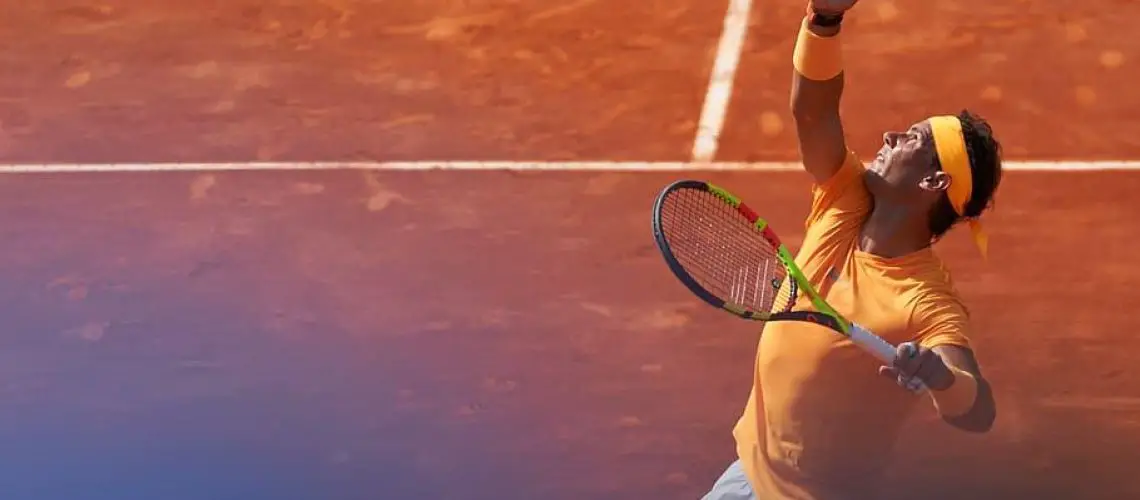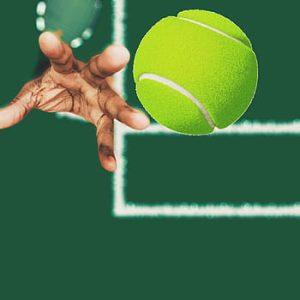We may earn money or products from the companies mentioned in this post.
Introduction to Tennis Racket Manufacturing
In the world of tennis, the racket is an essential tool that can make or break a player’s performance From the early days of wooden rackets to today’s advanced composite materials, the evolution of tennis racket manufacturing has been fascinating Let’s take a closer look at how these sporting instruments have evolved over time
Early Wooden Rackets
Back in the day, tennis rackets were crafted from simple wooden frames These early prototypes had a limited lifespan and were prone to breaking under intense gameplay However, they laid the foundation for future innovations in racket design
The Evolution of Metal and Composite Materials
With advancements in technology came new possibilities for tennis racket manufacturing Metal frames made their debut in the mid-20th century, providing players with more durability and power This marked a significant shift in the sport as players could now unleash stronger shots without worrying about their racket breaking
In recent years, composite materials like carbon fiber have taken center stage in racket construction These high-performance materials offer optimal strength-to-weight ratios and enhanced control on the court Manufacturers experiment with different combinations of materials to create rackets that cater to every player’s unique needs and playing style
Importance of a Well-Crafted Racket in the Sport

A well-crafted tennis racket can greatly impact a player’s game, both at a professional level and for recreational players alike
Professional Players’ Preferences
Professional players often have specific preferences when it comes to their choice of racket They seek equipment that complements their playing style and maximizes their performance on the court Customization options such as grip size, weight distribution, and string tension allow them to fine-tune their racket to perfection
For example, some players may prefer a heavier racket for added power, while others might opt for a lighter one to increase maneuverability The balance between power and control is crucial, and manufacturers work tirelessly to meet the demands of professional athletes
Customization and Personalization Options
Tennis racket manufacturers understand that every player is unique and has different needs That’s why they offer customization options to cater to individual preferences From choosing the grip size that feels comfortable in hand to selecting specific string patterns for optimal spin control, players can personalize their rackets according to their liking
This level of customization not only enhances performance but also fosters a sense of connection between the player and their equipment It allows them to develop a deeper understanding of their game and develop trust in their racket’s capabilities
In conclusion, tennis racket manufacturing has come a long way since the days of wooden frames The use of advanced materials combined with customization options has revolutionized the sport by providing players with rackets tailored to their unique style and needs As technology continues to advance, we can only anticipate more exciting developments in this ever-evolving field
Materials and Components of a Tennis Racket

Tennis rackets are made up of various materials and components that contribute to their performance, durability, and overall feel Let’s explore the different elements that make up a tennis racket
Frame Materials: Types, Properties, and Purposes
When it comes to the frame of a tennis racket, there are several material options available Each material has its own unique properties and serves a specific purpose in terms of playability
1 Wood:
Wood was once the traditional material used for tennis racket frames While it may evoke a sense of nostalgia for some players, wooden rackets are now rarely used due to their relatively heavy weight and lack of power compared to modern alternatives
2 Aluminum:
Aluminum is a popular choice for beginners or recreational players who prioritize lightweight rackets While aluminum frames offer easier maneuverability on the court, they may lack the durability needed for intense gameplay
3 Graphite:
Graphite is considered the gold standard in modern tennis racket construction due to its excellent combination of performance and durability Graphite frames provide enhanced power, control, and stability, making them the preferred choice among professional players and serious enthusiasts
Strings: Tension, Gauge, and Composition Options
The strings play a crucial role in determining how a tennis racket feels when striking the ball They affect factors such as power, spin potential, control, and comfort during play There are two main types of strings commonly used: natural gut strings and synthetic strings
1Natural Gut Strings:
Natural gut strings are considered high-performance but come at a higher price point compared to synthetic alternatives These strings are made from the intestines of cows and possess exceptional elasticity, providing excellent power and feel They offer a comfortable playing experience with reduced shock transmission to the player’s arm
a) Properties and Advantages:
Natural gut strings have superior tension maintenance, allowing players to retain control over their shots for longer periods They also provide better touch and feel on the ball, enabling players to generate precise shots with ease The natural gut’s elastic properties contribute to enhanced power and spin potential
b) Care Requirements:
Due to their organic nature, natural gut strings require extra care to maintain their performance Players must avoid excessive moisture exposure and extreme temperatures that can degrade the material Regular restringing is also recommended for optimal performance
2 Synthetic Strings:
Synthetic strings are affordable alternatives that offer various options in terms of composition, including nylon, polyester, and multifilament materials
a) Nylon Strings:
Nylon strings are a popular choice among recreational players due to their affordability and durability They provide a good balance between power and control while offering decent comfort during play
b) Polyester Strings:
Polyester strings are known for their durability and ability to generate significant spin on the ball These strings offer excellent control but may be less forgiving on the player’s arm due to their stiffer nature
c) Multifilament Strings:
Multifilament strings aim to replicate the playability of natural gut while offering improved durability They consist of multiple strands intertwined together, providing enhanced power, comfort, and feel compared to other synthetic options
Manufacturing Process of Tennis Rackets

Tennis rackets are meticulously crafted using a multi-step manufacturing process that ensures optimal performance and durability on the court Understanding how these rackets are made can provide valuable insights into the technology and craftsmanship behind this essential piece of tennis equipment
Frame Manufacturing Process:
The frame is the backbone of any tennis racket, and its construction involves several key steps
1 Creating the Mold – Design Process
The first step in manufacturing a tennis racket frame is designing the mold Computer-aided design (CAD) software allows engineers to create precise models of the racket’s shape and dimensions Once the design is finalized, CNC machines are used to carve out the mold, ensuring accuracy and consistency in each racket produced
2 Material Layup – Layering Materials
In order to achieve optimal strength and flexibility, tennis racket frames are composed of layered materials The fiber orientation plays a crucial role in determining these characteristics By strategically aligning fibers during the layup process, manufacturers can enhance specific areas of the frame for improved performance Resin is then used to bind these layers together, creating a sturdy composite structure
3 Curing Process – Strengthening the Frame
To further strengthen the frame, it undergoes a curing process that solidifies its structure Two common techniques employed during this stage are vacuum bagging and autoclave curing methods
-
Vacuum Bagging Technique:
The frame is enclosed in a specialized bag that removes air from around it while applying pressure evenly This technique ensures proper consolidation of materials and helps eliminate voids or imperfections within the frame -
Autoclave Curing Method:
In this method, the frame is subjected to high temperatures and pressure within an autoclave chamber This process allows for thorough bonding of materials and results in a stronger and more durable racket frame
Stringing Process:
The stringing process involves installing the main strings and cross strings onto the racket frame, creating the string bed that affects performance and playability
1 Main String Installation – Vertical Alignment
The main strings are installed vertically on the racket frame, and this step requires precise techniques for optimal tension and alignment
-
Starting Knot Techniques:
Various knotting techniques are used to secure the starting end of the main strings These knots ensure proper tension maintenance throughout gameplay -
Tension Maintenance:
Maintaining consistent tension across all main strings is crucial for uniform performance Skilled stringers use specialized tools to carefully adjust tension while stringing each individual main string
2 Cross String Installation – Horizontal Alignment
In this step, cross strings are woven horizontally through the vertical main strings to create a grid-like pattern on the racket face
-
Weaving Pattern Consistency:
Achieving consistent weaving patterns ensures uniformity in string bed stiffness, providing players with predictable ball response and control -
Lacing Methods:
There are different lacing methods employed during cross string installation, such as two-piece or continuous lacing techniques Each method has its own advantages in terms of ease of installation and potential for customization
Final Assembly:
The final assembly stage involves adding finishing touches to the racket before it is ready for use on the court
1 Grip Installation
The grip is an essential component of a tennis racket, providing players with comfort, control, and a secure hold During grip installation, players can choose between overgrips or replacement grips based on their preferences and playing style Additionally, different taping techniques are employed to secure the grip in place and enhance player comfort
2 Quality Control and Inspection
Before leaving the manufacturing facility, each tennis racket undergoes rigorous quality control measures to ensure it meets the highest standards of performance and durability
-
Frame Measurements:
Precise measurements are taken to verify that the racket frame adheres to specifications regarding weight, balance point, head size, and overall dimensions -
String Tension Accuracy:
String tension is carefully measured using specialized equipment to ensure accuracy and consistency across all rackets produced
The manufacturing process of tennis rackets involves a combination of advanced technology, skilled craftsmanship, and attention to detail Each step contributes to creating rackets that deliver optimal performance on the court while satisfying the unique needs of players at different skill levels
Choosing the Perfect Tennis Racket for You
When it comes to selecting the ideal tennis racket, there are several factors to consider One of the key considerations is the size and weight of the racket
Racket Size: Power vs Control
The head size of a tennis racket plays a crucial role in determining the balance between power and control Oversize rackets offer a larger head size, providing more power with each shot On the other hand, midsize rackets offer greater control due to their smaller head size
-
Oversize Rackets:
These rackets are perfect for players who want extra power in their shots The larger sweet spot allows for better contact with the ball, resulting in powerful strokes -
Midsize Rackets:
For players who prioritize control over power, midsize rackets are an excellent choice Although they may require more precision, these rackets provide better maneuverability on the court
Weight Distribution: Head-Heavy, Head-Light, or Balanced?
In addition to head size, weight distribution also impacts your playing style There are three main types of weight distribution in tennis rackets: head-heavy, head-light, and balanced
-
Head-Heavy:
Rackets with a higher weight toward the head offer more power and stability during shots This type of racket is beneficial for players with slower swing speeds or those seeking additional assistance generating power -
Head-Light:
With less weight at the top of the frame, head-light rackets provide increased maneuverability and control over shots These rackets are suitable for players who rely on fast swings and quick reactions -
Balanced:
As the name suggests, balanced rackets strike a middle ground between head-heavy and head-light They offer a blend of power and control, making them versatile options for players with varying playing styles
String Tension and Pattern Preferences
The tension and pattern of your racket’s strings can greatly impact your game Players have the choice to opt for higher or lower string tensions based on their desired outcome
-
Higher Tension:
Increasing the tension of the strings provides enhanced control over shots The ball stays on the strings longer, allowing for more precision when placing shots -
Lower Tension:
Lowering string tension results in a trampoline-like effect, generating more power in each stroke This can be advantageous for players who rely on strong serves or aggressive playing styles
Selecting Grip Size and Shape
The grip size and shape of a tennis racket are crucial factors that directly affect comfort and control during gameplay It’s essential to find the right fit for your hand
-
Measuring Hand Size:
Determining your hand size is vital in selecting an appropriate grip size You can measure it by holding a ruler against your palm from the base to the tip of your ring finger -
Importance of Comfortable and Secure Grip:
A comfortable grip allows you to maintain control over your racket while minimizing strain on your hand and wrist It ensures better shot execution throughout long matches or intense practice sessions
Consulting with Professionals or Experienced Players
If you’re still unsure about which tennis racket suits you best, seeking advice from professionals or experienced players can be incredibly helpful
-
Seek Advice from Coaches or Racket Technicians:
Coaches and racket technicians possess in-depth knowledge about different rackets and can provide valuable insights tailored to your playing style and skill level -
Testing Various Rackets:
Before making a final decision, it’s advisable to test out different rackets This hands-on experience allows you to feel the differences in weight, balance, grip size, and overall performance
By considering factors such as racket size and weight, string tension and pattern preferences, grip size and shape, as well as seeking guidance from experts, you’ll be well on your way to finding the perfect tennis racket that complements your playing style and helps take your game to new heights
Useful Links

Tennis technology
Making a racket: the science of tennis – Plus Magazine
String theory: the evolution of the tennis racket
HISTORY OF RACKETS AND STRINGS
What Are Tennis Racquets Made of?
Evolution of the Tennis Racket
Tennis Racket
The History of Tennis Racquets
Tennis Racket: Components, Specifications & How it’s Made
What Are Tennis Strings Made Of?
Natural gut tennis racket strings: The history, myths and …
How Many Cows Does It Take To String A Tennis Racquet?
Racket Technology: That Extra Inch Made the Difference
Tennis: a smashing history of how rackets shaped the game
The Emergence of Graphite
Where Are Tennis Racquets Made? [Full Stats]
How to Choose a Tennis String






